
Claude 'Claudie' Grahame-White (1879 - 1959)
Claude Grahame-White, born at Southhampton on 31 August 1879 and educated at Bedford Grammar School had been a yachtsman, a motoring enthusiast, and a dealer in automobiles before he was converted to aviation at the Rheims meeting in 1909. Forthwith, he had ordered a duplicate of Blériot's ill-fated Model XII; and to become acquainted with its construction he enrolled as a worker in the Blériot establishment at Neuilly-sur-Seine.
The Model XII, however, had only a brief career. A miscalculation on landing one day, with Blériot himself at the controls, resulted in the two-seated monoplane being wrecked; it was the last of its kind. Grahame-White returned to London and began the development of a great flying center at Hendon, on what was then a vacant, weed-covered lot. At the same time he entered the Henry Farman school at Chalons, learning to fly the biplane with which he would become famous for a dramatic dash in the dark of the night, racing Louis Paulhan for a 10,000 pound prize offered by the Daily Mail. The course from London to Manchester --- a distance of 183 miles --- had to be covered within 24 hours.
Excerpt from From Blue Ribbon of the Air
Grahame White Grahame White was one of the first Britons to exploit aviation commercially after achieving heroic status for narrowly losing the £10,000 prize the Daily Mail offered for the first London to Manchester flight to a Frenchman! He went on to scoop almost all the prizes on a tour of America which included a flight into the White House grounds where he invited President Taft up for a flight. As Taft weighed 21 stone it is probably as well that he declined !
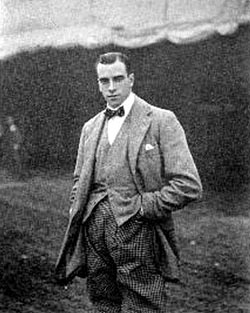 Claude Grahame-White, c.1912
By now White had made a fortune and he invested it wisely in 220 acres of pasture at Hendon, turning it into London's first aerodrome. For 3 years up to the outbreak of WW1 the weekend flying displays there were the greatest attraction in London and the aircraft he designed, which were boxkite affairs not unlike Farmans and Bristol Boxkites, formed the backbone of his Flying School.
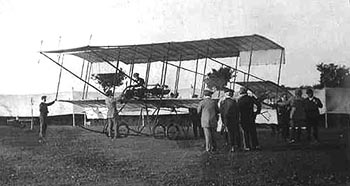 CW 'Boxkite' Variant, c.1911
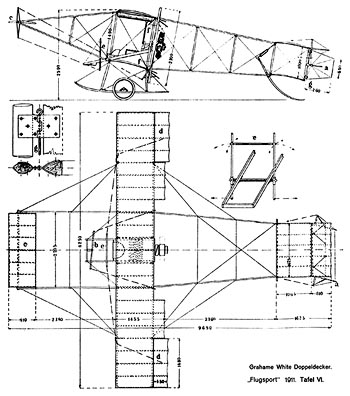 CW 'Boxkite' Variant, 1911 http://members.rogers.com/nieuport download a 1000pixel image
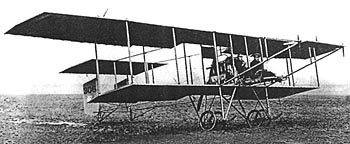 CW 'Boxkite' Variant, c.1912 download a 1000pixel image
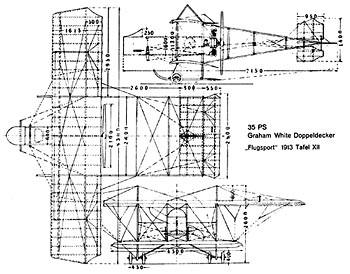 GW XV development, 1913 http://members.rogers.com/nieuport download a 1000pixel image
They were also used for the first demonstration of aerial bombing, straffing and pioneering night flying. On the outbreak of WWI he joined the Royal Naval Air Service and took part in attacks on German held ports before resigning to manage his business, whose staff had increased from 20 to 1000 due to war contracts. The company built a number of aircraft under licence (Air-Co DH 6, Morane Saulnier G/H) plus a number of aircraft of their own design, including the Type XV pilot trainers, as the boxkites were now designated, despite being very different to the original machines of 1912. The XV trainers were the type used by 48 Reserve Sqn at Waddington from November 1916 to June 1917, as they were established for 18 machines, and A1700 was definitely on their charge. Along with Farman Shorthorns they were the first aircraft based here.
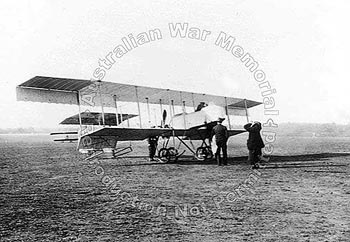 GW XV, c.1916 download a 750pixel image Australian War Memorial. File # 42162
Judging by the lack of information they were not particularly charismatic aircraft but they were made in a variety of forms from 1912 - 17, undergoing a gradual evolution, losing the front elevator and having a cockpit nacelle, aileron balance cables, top wing extensions and dual controls fitted.
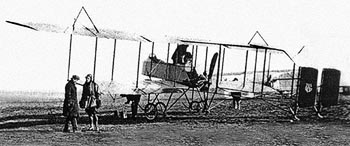 GW XV, c.1916 download a 750pixel image
60hp Le Rhone, 70 & 80hp Gnome and 60hp Green engines were among those used to power this machine so there appears to have been a huge variation of types built under the general umbrella name of GW XV! At present we do not know the exact type used at Waddington. It is possible, but unlikely that other GW types were also used here. We do know that White was out of favour by the end of the war and was forced to go to France looking for contracts. Eventually he became so disillusioned by Britain that he sold Hendon to the Air Ministry and emigrated to California where he was a realtor. In 1959 he died in Nice on his 80th birthday. Hendon is now the main site of the RAF Museum so perhaps it is not surprising that they were the only people able to provide us with some information on his aircraft.
The original site : http://www.raf-waddington.com/ notes that their page is intended to provide a source of Grahame White imagery for general release. Anyone can send us an image or information to be placed on this page. We would be most grateful as we cannot very much at all!
Volume 1 of the station archive is currently missing - if you know where it is please contact the CRO. Photographers will be acknowledged, but publication on this page marks the image as royalty free and available for download. Thanks are due to Gordon Leith of the RAF Museum Hendon for his help with this page. During July/August 1912. J.L. Travers and Claude Graeme-White on their 'Wake Up England' campaign, flew a Henri Farman HF.22 covered in bright blue fabric and had the 'Wake Up England' slogan across the wings in bright yellow A 2view colour image of this craft appears in Munson, K., Pioneer Aircraft 1903-14, Blandford, 1969
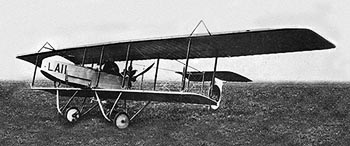 Henri Farman HF.22 download a 750pixel image
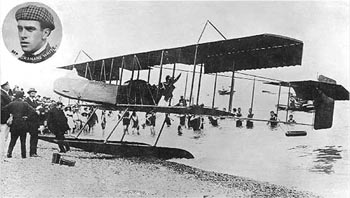 Henri Farman HF.22 Hydro download a 750pixel image http://members.shaw.ca/flyingaces/archive1.htm
Aviation Display The summer of 1911 saw the Coronation of King George V with great rejoicings throughout the Island. It was also the year when Douglas celebrated its Jubilee as a municipality and, being one of the leading resorts, a lavish programme of events was arranged for both residents and holiday-makers. By far the most novel idea was to be an Aviation Display by two of the leading aviators of the day whose flying machines would be the first to be seen in Manx skies. Highlight of their visit would be a 'race' between them and the Ben-my-Chree, pride of the Steam Packet fleet.
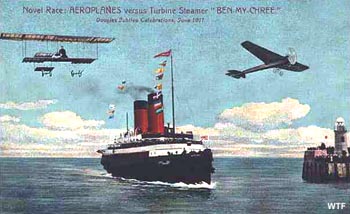 Aviation Display
As the ship sailed round the Island the two machines would circle round above and present a spectacle for all to see. The flying machines would use the playing fields of the newly opened Noble's Park as an aerodrome and would be accommodated in specially constructed hangars. To help offset the heavy expenses there was to be an admission charge of 6d to the area enclosed by canvas screening with similar enclosures round the Island at Port Lewaigue, Peel and Rushen where the machines would also make a landing. The great event was planned for the afternoon of Tuesday, 4th July. The two pilots contracted to take part were Claude Grahame-White and George Barnes who would come to the Island after competing in the Daily Mail Paris to London Race. Their two machines preceded them by ship before being transported to the aerodrome. ...more
Claude Grahame-White Dies Well known to Early Birds was Claude Grahame-White who died in Nice, France, August 19, 1959. Mr. Grahame-White in 1909 turned his attention to aeronautics, opening the first British flying school. He was the first English pilot to carry mail in Britain, and was the first to fly by night.
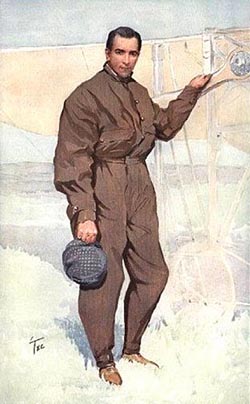 'Claudie'. In flying clothes
Aviator, Claude Grahame-White
His later aviation interests were extensive. He was the author of numerous books on aviation. The Early Birds of Aviation CHIRP, January, 1960, Number 62
Gordon Bennett Air Race The First Gordon Bennett Air Race took place in 1910 in New York at Belmont Park. The winner was Claude Grahame-White at the speed of 62 mph flying a Gnome-Blériot
Daily Mail Prize 21 April 1910 : Claude Grahame-White makes his first attempt to capture the Daily Mail prize of £10,000 offered in 1906 for the first flight between London and Manchester in a 24 hour period. However he was forced to land near Lichfield with a misfiring engine, and by the time he could resume the flight the winds were too strong, preventing him being able to accomplish it in the 24 hour period allowed. He was ready to try again on 27 April, however by this time so was the Frenchman Louis Paulhan. Paulhan was ahead of Grahame-White from the start of the race, and despite Grahame-White flying at night in an attempt to catch him, a very daring feat for the time, he could not and the prize went to Paulhan
Claude Grahame-White : Blériot Confusion I would like to add a follow-on to Sanford Solarz's letter in the September 2000 issue of Aviation History concerning confusion between the Blériot XI and XII. In Solarz's letter he states that, to the best of his knowledge, the Blériot XII was only flown by one person, Louis Blériot himself. While I don't want to flog this horse to death, this isn't quite true. Joshua Stoff, in his Picture History of Early Aviation, 1903-1913, states that a Blériot XII was the first airplane owned by the English sporting pilot, Claude Grahame-White. On page 31 of the same book Grahame-White is seen leaning against an airplane that certainly looks like a Blériot XII; just as clearly, it is not the Blériot XII usually shown in photographs. In Contact!, Henry Villard writes that Grahame-White was one of Blériot's first pupils, and was taught to fly at Issy in a duplicate of Blériot's model XII. Grahame-White then took his Blériot XII from Issy to Pau. Wallace, in his Flying Witness, agrees that Grahame-White managed to convince Blériot to build for him a duplicate of Blériot's "big 60-hp monoplane." He then adds that, on the day Grahame-White was to take delivery (of the Blériot XII) at Issy, Blériot was detained elsewhere. Growing impatient, Grahame-White essentially taught himself to fly in his machine on the way to Pau. It was there in Pau that the machine crashed with Blériot at the controls and Grahame-White as a passenger. After that, Blériot decided that the XII was not worthy of further development, and he gave Grahame-White two Blériot XI airplanes as compensation for his lost model XII. I hope this fleshes out one more of those interesting footnotes in early aviation history.
Colin Green Send letters to:
Aviation History Editor e-mail to AviationHistory@thehistorynet.com Please include your name, address and daytime telephone number. Letters may be edited.
Further Reading Grahame-White, Claude : Aviation.; London: Collins, [1912]. The Nation's Library series. Small 8vo (7" x 4.5"). 262 pp. Red cloth. Near fine in modern protective clear plastic sleeve. One of the first aviation books to be produced by a general, rather than specialist, publisher indicating that the subject was now starting to hold popular appeal. Wallace G., Claude Grahame-White : A Biography; (Putnam London) 1st 1960 British pioneer pilot (at 28) & aircraft manufacturer, air racer, Hendon, Flt Cdr Royal Naval Air Service, successfully sued British Govt 256pp 62 early photos
|
© Copyright 1999-2005 CTIE - All Rights Reserved - Caution |
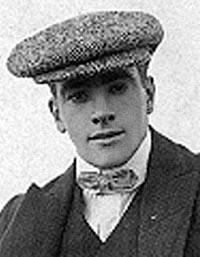 Claude Grahame-White
Claude Grahame-White